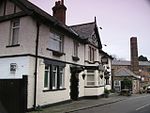Vindolanda
Archaeological museums in EnglandArchaeological sites in NorthumberlandFormer populated places in NorthumberlandHistory of NorthumberlandMuseums in Northumberland ... and 4 more
Museums of ancient Rome in the United KingdomRoman auxiliary forts in EnglandStanegateUse British English from October 2013

Vindolanda was a Roman auxiliary fort (castrum) just south of Hadrian's Wall in northern England, which it pre-dated. Archaeological excavations of the site show it was under Roman occupation from roughly 85 AD to 370 AD. Located near the modern village of Bardon Mill in Northumberland, it guarded the Stanegate, the Roman road from the River Tyne to the Solway Firth. It is noted for the Vindolanda tablets, a set of wooden leaf-tablets that were, at the time of their discovery, the oldest surviving handwritten documents in Britain.
Excerpt from the Wikipedia article Vindolanda (License: CC BY-SA 3.0, Authors, Images).Vindolanda
Stanegate,
Geographical coordinates (GPS) Address Website External links Nearby Places Show on map
Geographical coordinates (GPS)
| Latitude | Longitude |
|---|---|
| N 54.9911 ° | E -2.3608 ° |
Address
Vindolanda Fort (Castra Vindolanda)
Stanegate
NE47 7JN
England, United Kingdom
Open on Google Maps








